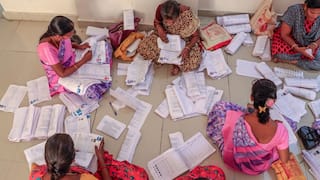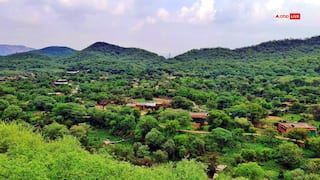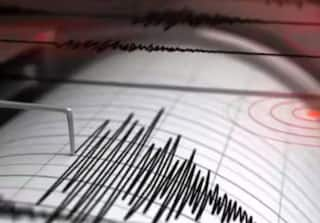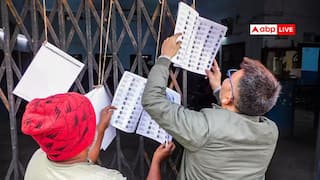Explorer
India's looming water crisis: The way forward

Representational Picture (AFP)
India has seven major rivers. And yet, large parts of the country face water shortages, for irrigation or drinking or sanitation or industrial purpose. Besides, States are forever in conflict over sharing of inter-State river waters. Many tribunals have been set up and they have given awards that have not been accepted. Matters have also reached the doors of the courts but they have been dragging on for decades.
Much of the water problem in our country has to do with mismatch in the demand and supply graph. While the country's population, needs and economic activities are growing rapidly, we have failed to keep pace with the per capita availability of water. From 5,177 cubic metres in 1951, the per capita availability fell to 1,123 cubic metresin 2015. Worse, with a manifold rise in population, it has been predicted that this will dip further to 1,140 cubic metres in 2050. And it is this inequity in the availability of fresh water that has provided fertile ground for several inter-State and intra-State disputes.
Given the United Nations’ projection that India's population will see a rise of about 50 per cent, we can imagine a future where the country may have to import water. Many foreign players are already eying big investment opportunities in the water sector. More than 12 international companies have set up design and engineering centres in Mumbai and Pune.
The water problem is largely man-made. Our tendency to over-exploit the availability of water, in addition to the growing needs and urbanisation, has amplified the problem. Appeasement policies of various Governments have added to crisis.
Subsidised water policies, and the inability of Governments to successfully treat waste water for re-use,has worsened the situation. Since water is charged at a minimal cost or at no cost at all, States have not been able to generate the required amount of funds required for infrastructural purposes like building of piped water lines or for recycling of waste water.
Changes in climatic conditions due to global warming have contributed too. While back-to-back droughts have become a normal phenomenon, sometimes we are also witness to floods and cyclones — all of which are extreme weather conditions that lead to human distress. However, what is alarming is that the frequency of calamity-like situations has increased in recent decades. Rainfall distribution in the country has been unequal, with some parts receiving rains and others going dry.
ALSO READ: PM must take lead in resolving Ayodhya issue, ending cow slaughter
Many climatic problems are caused by air pollution from automobiles and factories which significantly contributestowards the creation of aerosols, which in turn have the capacity to cool the air, thus reducing the strength of winds. Most likely, a warmer climate results in heavy rainfall than a cool atmosphere, which leads to increased chances of dry spells. While broad agreements on climate models are being discussed globally, there are no promises on how these changes will impact the weather.
Of the two water resources in the country — surface water and ground water — there is a skewed pattern in their usage. The latter accounts for about 55 per cent of the water usage of the country. Sixty per cent is used for irrigation purposes. And, 30 per cent of urban water supply and 70 per cent of rural water supply come from ground water. Efforts to restore this natural source of water, through rain water storage, has been lacking. India's inability to store rain water has augmented the problem.
Even during a bad monsoon, the minimum amount of rainfall that the country receives is 2,600 bcm of rain, while it needs around 1,100 bcm to meet all requirements. The problem, therefore, is not with the amount of waterreceived but with the capacity to store rain water, which is just about 250 bcm.
The problem is further exacerbated by the agriculture sector, which accounts for nearly 80 per cent of annual consumption. Agricultural practices are such that most farmers are not trained in water management techniques. Considered to be India's lifeline, agriculture is highly dependent on monsoons, which have in the past decades been irregular. The last excess rainfall year was in 1994.
Managing an optimum level of moisture in the soil hold the key to a good yield. But farmers still practice the age-old tradition of over-flowing their fields with water and indiscriminate use of urea and fertilisers (both subsidised). This has become counter-productive as it has affected crop yield. Farmers must develop the habit of using drones and sprinklers, pumps and pipes for equal distribution of water. Building dams, canals and reservoirs will not suffice to address the water problem for agricultural purposes, as such measures take years to become a reality.
Weak policies and ineffective regulatory bodies too have led to failure in maintaining a check on industrial waste. Industries to a larger extent, contribute to anthropogenic pollution which is caused due to waste flowing into our rivers, ponds and lakes.
The harmful effects of chemicals, both pesticides and fertilisers, and also untreated industrial effluents, do not require enumeration. Decades of pollution have rendered our rivers breathless as they choke with pollution. The grant of legal rights to the Ganga and Yamuna as living entities by the Uttarakhand High Court is a landmark judgement. Hopefully, the authorities concerned will be now compelled to pay more heed to the health of these ‘living entities’.
Yet another problem is that we don't have any credible data on water. A State's water data wardrobe is largely hidden from public view. And States have always been at loggerheads over first use of water and cite various available water statistics, which is often poor or untrustworthy, and rejected by the other side.
Perhaps at one point of time, we had so much access to cheap and clean water that we have taken this natural commodity for granted. India is in the ‘water-stressed’ category but has not plunged to the ‘water scarcity' level yet. It’s not too late to course-correct.
(The writer is Assistant Editor, The Pioneer. Twitter ID: @shreya_kedia )
Disclaimer: The opinions, beliefs and views expressed by the various authors and forum participants on this website are personal and do not reflect the opinions, beliefs and views of ABP News Network Pvt Ltd.
Follow Blog News on ABP Live for more latest stories and trending topics. Watch breaking news and top headlines online on ABP News LIVE TV
View More


























